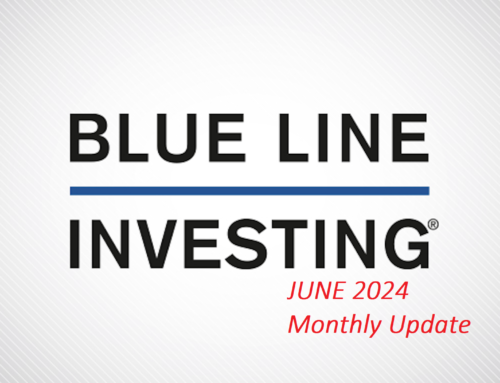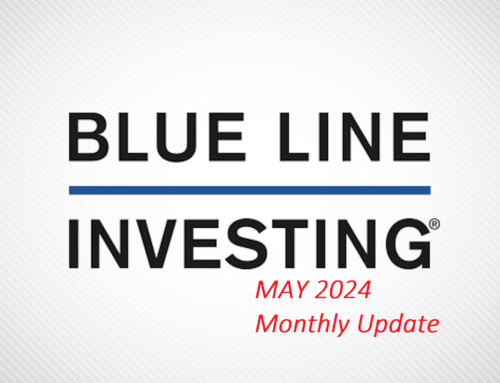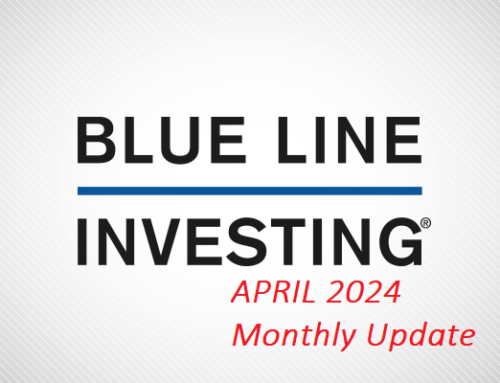“The only thing that is constant is change”
– Heraclitus
The US stock market, as measured by the S&P 500 Index (S&P), finished the month of November 7.10% above the BLUE LINE, compared to 4.91% at the end of October. The primary trend is currently categorized as Positive.
BLUE LINE PERSPECTIVE

Chart courtesy of StockCharts.com
As a quick reminder, we monitor the relationship between price and the BLUE LINE over time to help identify which stock markets worldwide are experiencing rising primary trends, sideways primary trends, and declining primary trends. We prefer to invest in those markets experiencing rising or sideways primary trends, while avoiding those markets experiencing declining primary trends. The BLUE LINE helps us identify these trends – and when changes may be taking place between them.
TREND CHANNEL PERSPECTIVE
Last month I mentioned I was cautiously categorizing the primary trend as positive. With several client inquiries I will clarify what I meant by that, by putting the current stock market trends into context with the past. Please review the chart below of the S&P 500 Index from 1965 through 1969.

Chart courtesy of StockCharts.com
When looking at the five-year chart above, what you see is a rising trend channel labeled “A” that experienced a price correction labeled “C” in 1966. When the price correction completed, a price rally resumed forming a new rising trend channel labeled “B.” As prices rose, they were stopped by the previous green dashed line, identified by the three gray arrows. Thereafter, price corrected further down to the lowest green dashed line to establish the new rising trend. Price bounced off that green line and rose higher, eventually experiencing a “price top” in late 1968, declining thereafter. The S&P 500 lost over 25% of its value when the trend changed and declined from late 1968 into 1970.
How does the current trend today compare to the mid-to-late 1960’s? Please review the chart below of the S&P 500 Index from 2015 through today.

Chart courtesy of StockCharts.com
When looking at the five-year chart above, what you see is a rising trend channel labeled “A” that experienced a price correction labeled “C” at the end of 2018. When the price correction completed, a price rally resumed forming a new rising trend channel labeled “B.” With this year’s price rally, price has been stopped at the previous green dashed line, identified by the three gray arrows. So, if history decides to repeat itself, it is possible for price to correct down to the lowest green dashed line at some point in the months ahead to establish the new rising trend. Unless the S&P 500 eventually rises back into the original trend labeled “A”, I believe the danger increases that the market could form at least a temporary top within the next year or two, like the late 1960’s. If this occurs, a sell process could come in handy to attempt to limit investment loss should price decline below and remain below the BLUE LINE.
Thank you for reading the BLUE LINE INVESTING® PRIMARY TREND update, and please do not hesitate to call us at (833) 258-2583 with questions or if we may be of service.
Jeff Link
Would you find this service more beneficial in video format? If so, please let me know by sending an email to [email protected]. I am considering changing format to a Zoom presentation to narrate this in the future for further clarity.
Disclaimers:
BLUE LINE INVESTING® (BLI) is an investment process that seeks to align investment decisions with the prevailing primary trend of the financial markets. BLI seeks to remain fully invested when the financial markets are experiencing either a long-term rising primary trend or a short-to-intermediate sideways trend. When the primary trend begins declining however, the process follows a 3-phase sell process to attempt to limit downside loss. We believe Warren Buffett said it best with his two rules: “Rule No. 1 – Never lose money. Rule No. 2 – Never forget Rule No. 1.”
The S&P 500 Index is one of the most commonly followed equity indices, and many consider it one of the best representations of the U.S. stock market, and a bellwether for the U.S. economy. It is comprised of 500 large companies having common stock listed on the NYSE or NASDAQ. The volatility (beta) of the account may be greater or less than the index. It is not possible to invest directly in this index.
Technical analysis is a method of evaluating securities by analyzing statistics generated by market activity, such as past prices and volumes. Technical analysis attempts to predict a future stock price or direction based on market trends. The assumption is that the market follows discernible patterns and if these patterns can be identified then a prediction can be made. The risk is that markets may not always follow patterns. There are certain limitations to technical analysis research, such as the calculation results being impacted by changes in security price during periods of market volatility. Technical analysis is one of many indicators that may be used to analyze market data for investing purposes and should not be considered a guaranteed prediction of market activity. The opinions expressed are those of BLI. The opinions referenced are as of the date of publication and are subject to change without notice. BLI reserves the right to modify its current investment strategies based on changing market dynamics or client needs.
Past performance is not indicative of future results. This material is not financial advice or an offer to sell any product. The information contained herein should not be considered a recommendation to purchase or sell any particular security. Forward looking statements cannot be guaranteed.
Advisory services offered through Aptus Capital Advisors, LLC, a Registered Investment Adviser registered with the Securities and Exchange Commission. Registration does not imply a certain level or skill or training. More information about the advisor, its investment strategies and objectives, is included in the firm’s Form ADV Part 2, which can be obtained, at no charge, by calling (251) 517-7198. Aptus Capital Advisors, LLC is headquartered in Fairhope, Alabama.
ACA-19-20




